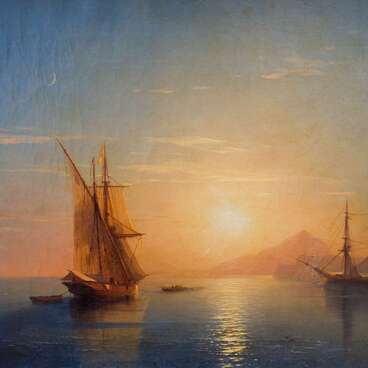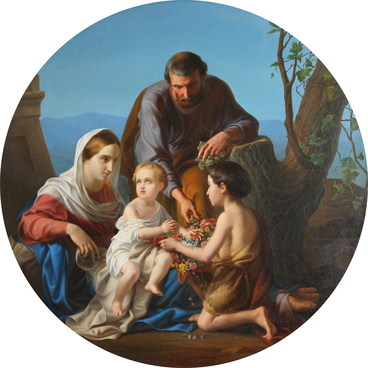Johan Batist Joseph Bastine, a representative of the classical direction in painting, was a graduate of the Leuven Art Academy (Belgium), a student of outstanding representative of neoclassicism Jacques Louis David and a friend of Jean Auguste Dominique Ingres, with whom he learnt secrets of painting from the same master. In the early 19th century, in 1811, Johan Baptist moved to the Prussian Aachen, where, as his teacher before him, he also founded a school of his own and taught drawing in the local gymnasium.
Bastine painted his most significant work, Return of Tobias, even before he left for Prussia, in Paris. He took the subject for that painting from an Old Testament story, urging to think about eternal values - family, piety and fidelity.
According to that story, Tobias, the son of Tobit, famous for his piety, was captured and taken away with his family and other natives of the Land of Israel to Nineveh. Even in captivity, Tobit, the father of Tobias, remained kind and buried dead people, who were left without burial because of poverty, or were executed on orders of the king, according to Jewish customs.
But once Assyrian King Sennahirim grew to hate the entire tribe of Jews and ordered to kill them mercilessly. It was forbidden to bury the dead, nevertheless Tobit continued to do that and paid the price for it - he was sentenced to death. The patriarch fled Nineveh, but when the cruel king died, he returned.
Once Tobit buried a murdered Israeli and had to spend the night at the walls of his house. At night, the pious Israeli got a sparrow dropping into his eyes, which resulted in Tobit’s blindness. When the patriarch lost sight, the family became impoverished and could barely feed themselves. Then Tobit sent his son Tobias to Ragah of Mediah, where he once had left 10 talents to an Israeli named Havael.
The young man’s companion was angel Raphael himself, who called himself Azariah. Tobias caught a huge fish and, following the advice of the companion, kept its insides. After many vicissitudes, Tobias returned home and attached the bile of the fish to his father’s eyes, and the latter recovered his sight.
This story was repeatedly referred to in painting: it was reproduced by Botticelli and Titian, Bugro and van Rayne. In the painting by Bastine, Tobit and his wife Anna are meeting their son at the gates of the city.
Bastine painted his most significant work, Return of Tobias, even before he left for Prussia, in Paris. He took the subject for that painting from an Old Testament story, urging to think about eternal values - family, piety and fidelity.
According to that story, Tobias, the son of Tobit, famous for his piety, was captured and taken away with his family and other natives of the Land of Israel to Nineveh. Even in captivity, Tobit, the father of Tobias, remained kind and buried dead people, who were left without burial because of poverty, or were executed on orders of the king, according to Jewish customs.
But once Assyrian King Sennahirim grew to hate the entire tribe of Jews and ordered to kill them mercilessly. It was forbidden to bury the dead, nevertheless Tobit continued to do that and paid the price for it - he was sentenced to death. The patriarch fled Nineveh, but when the cruel king died, he returned.
Once Tobit buried a murdered Israeli and had to spend the night at the walls of his house. At night, the pious Israeli got a sparrow dropping into his eyes, which resulted in Tobit’s blindness. When the patriarch lost sight, the family became impoverished and could barely feed themselves. Then Tobit sent his son Tobias to Ragah of Mediah, where he once had left 10 talents to an Israeli named Havael.
The young man’s companion was angel Raphael himself, who called himself Azariah. Tobias caught a huge fish and, following the advice of the companion, kept its insides. After many vicissitudes, Tobias returned home and attached the bile of the fish to his father’s eyes, and the latter recovered his sight.
This story was repeatedly referred to in painting: it was reproduced by Botticelli and Titian, Bugro and van Rayne. In the painting by Bastine, Tobit and his wife Anna are meeting their son at the gates of the city.
Plasticity of figures is masterfully conveyed, emphasis are placed with extreme precision, which is an indication of serious experience of the painter.
Visually, the composition is split in two parts. On the right one can see the delight of reunion, embracement of relatives and a joyfully barking dog (by the way, in many paintings, reproducing this Old Testament story, a dog is present). On the left, the wife and mother is speaking to Raphael-Azariah, and in the background of the painting one can see a hilly landscape and a yard of a peasant house.
The technique of the brush stroke and the warm color scheme are typical of graduates of the David’s school. Bastine was a master of light and shade and color contrasts. The figures are masterfully separated from the background, the scarlet Tobit’s cloak looks even brighter next to his son’s clothes. The green scarf of the wife and mother almost blends in with the wood crown, standing in sharp contrast with the red clothes and the brown cloak of Raphael.
Visually, the composition is split in two parts. On the right one can see the delight of reunion, embracement of relatives and a joyfully barking dog (by the way, in many paintings, reproducing this Old Testament story, a dog is present). On the left, the wife and mother is speaking to Raphael-Azariah, and in the background of the painting one can see a hilly landscape and a yard of a peasant house.
The technique of the brush stroke and the warm color scheme are typical of graduates of the David’s school. Bastine was a master of light and shade and color contrasts. The figures are masterfully separated from the background, the scarlet Tobit’s cloak looks even brighter next to his son’s clothes. The green scarf of the wife and mother almost blends in with the wood crown, standing in sharp contrast with the red clothes and the brown cloak of Raphael.

